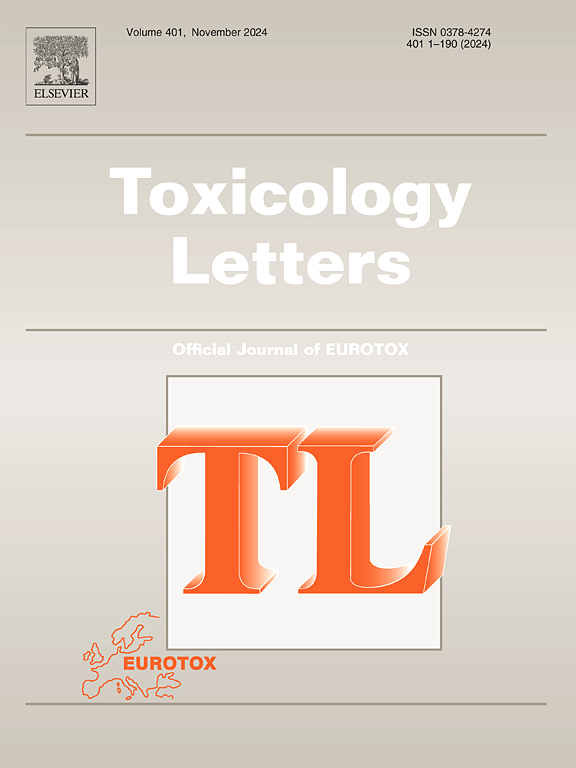氯氮平诱导醌氧化还原酶NQO1和NQO2:对氯氮平诱导的粒细胞缺乏症的潜在影响
IF 2.9
3区 医学
Q2 TOXICOLOGY
引用次数: 0
摘要
氯氮平在治疗难治性精神分裂症中表现出优越的疗效。然而,氯氮平目前被认为处方不足,因为它有特殊药物反应的风险(包括严重的中性粒细胞减少症或粒细胞缺乏症)。氯氮平诱导的粒细胞缺乏症机制正在演变。NADPH:醌氧化还原酶2 (NQO2)多态性与氯氮平诱导的粒细胞缺乏症相关的报道促使了本文的研究。氯氮平可以产生反应性的亲电代谢物。目前尚不清楚后者是否能像类醌亲电试剂那样与NQO2或NQO1相互作用。我们假设氯氮平或其代谢物可以通过Nrf2信号通路诱导NQO1和NQO2的表达,正如在类醌亲电试剂中观察到的那样。本研究使用HL-60细胞,因为它们与粒细胞/中性粒细胞相似,并且含有代谢氯氮平的酶。采用选择性底物和抑制剂,采用紫外可见分光光度法测定NQO1和NQO2酶活性。免疫印迹法检测NQO1、NQO2、Nrf2蛋白表达。RT-PCR检测NQO1和NQO2基因表达。氯氮平处理诱导NQO1和NQO2酶活性、mRNA和蛋白表达显著高于对照,并伴有转录因子Nrf2从细胞质向细胞核的易位。一种结构相关的抗精神病药奎硫平没有显示出这些作用。NQO1和NQO2酶活性、蛋白和基因表达的上调表明,这些酶可能参与了氯氮平毒性的生物学反应。Nrf2的易位提示Nrf2信号通路参与了这些反应通路。需要进一步的研究来确定NQO2的表达水平和活性是否是氯氮平诱导的粒细胞缺乏症的保护机制,或者NQO2水平是否是氯氮平诱导的粒细胞缺乏症的预后危险因素。本文章由计算机程序翻译,如有差异,请以英文原文为准。
The induction of quinone oxidoreductases NQO1 and NQO2 by clozapine: Potential implications for clozapine-induced agranulocytosis
Clozapine exhibits superior efficacy in the management of treatment-resistant schizophrenia. However, clozapine is currently considered under-prescribed as it carries a risk of idiosyncratic drug reactions (including severe neutropenia or agranulocytosis). The mechanisms of clozapine-induced agranulocytosis mechanisms are evolving. Reports of polymorphisms with NADPH: Quinone Oxidoreductase 2 (NQO2) being associated with clozapine-induced agranulocytosis prompted the studies described herein. Clozapine is known to produce reactive, electrophilic metabolites. It is not known if the latter can interact with NQO2 or with NQO1, its more well-characterized isoform, as quinoid electrophiles do. We hypothesized that clozapine or its metabolites can induce both NQO1 and NQO2 expression via the Nrf2 signaling pathway, as observed with quinoid electrophiles. HL-60 cells were used in this study as they are similar to granulocytes/neutrophils and contain enzymes to metabolize clozapine. A UV-Vis spectrophotometric assay was performed to determine NQO1 and NQO2 enzymatic activity using selective substrates and inhibitors. Immunoblotting was used to investigate NQO1, NQO2, and Nrf2 protein expression. NQO1 and NQO2 gene expression was determined using RT-PCR. Clozapine treatment induced NQO1 and NQO2 enzyme activity, mRNA, and protein expression significantly more than vehicle control accompanied by translocation of the transcription factor, Nrf2, from cytoplasm to nucleus. A structurally related antipsychotic, quetiapine, did not show these effects. The upregulation of both NQO1 and NQO2 enzymatic activity, protein, and gene expression indicated that these enzymes may be involved in the biological response to clozapine toxicity. The translocation of the Nrf2 suggested that the Nrf2 signaling pathway is involved in these response pathways. Further studies are required to determine if NQO2 expression levels and activity are protective mechanisms against clozapine-induced agranulocytosis or if NQO2 levels are a prognostic risk factor for clozapine-induced agranulocytosis.
求助全文
通过发布文献求助,成功后即可免费获取论文全文。
去求助
来源期刊

Toxicology letters
医学-毒理学
CiteScore
7.10
自引率
2.90%
发文量
897
审稿时长
33 days
期刊介绍:
An international journal for the rapid publication of novel reports on a range of aspects of toxicology, especially mechanisms of toxicity.
 求助内容:
求助内容: 应助结果提醒方式:
应助结果提醒方式:


